skip to main |
skip to sidebar
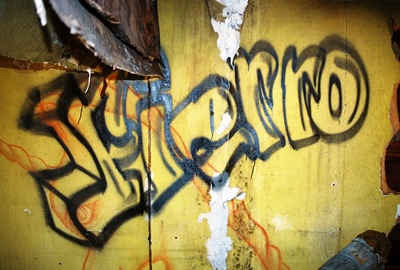
Yesterday’s post on the ghost town of Fierro, NM was heavily historical. In the introduction, I painted a portrait of Fierro as entirely vacant, quiet as a stone, a place where humans rarely tread these days. While that is relatively true, it’s not the entire picture, even aside from services at St. Anthony’s Mission Catholic Church and the occasional family reunion. Fierro does get visited and, judging by the evidence, its visitors are an interesting bunch. So, I thought it would be worth taking a look at who’s been there recently and what they’ve left behind. There might even be something here that'd be useful to know if you’re thinking of making the trip yourself.
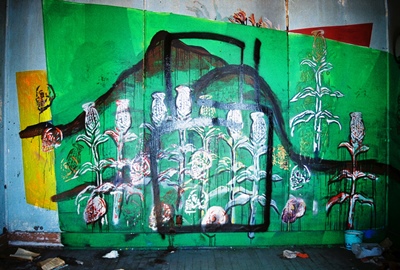
Most of the graffiti in Fierro is in the house shown at bottom, which was last owned by the Araujo family, who also operated Araujo’s Grocery in the building next door.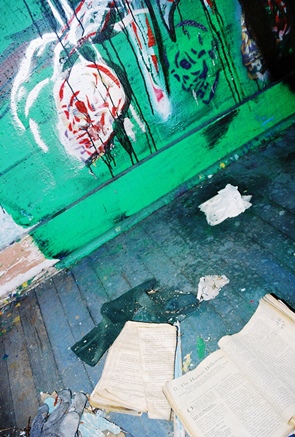 The Araujo’s rented the home out, but one person that probably didn’t sign a lease was whoever painted the green wall of skulls and maize set against the backdrop of a mountain shown above. The artist clearly spent some time in Fierro and, in fact, the room was swept clean and full of the evidence of a fairly prolonged stay. That evidence included some unusual reading material, such as a book about the influence of computers on society which lay open to a chapter titled, “The Human Difference.”
The Araujo’s rented the home out, but one person that probably didn’t sign a lease was whoever painted the green wall of skulls and maize set against the backdrop of a mountain shown above. The artist clearly spent some time in Fierro and, in fact, the room was swept clean and full of the evidence of a fairly prolonged stay. That evidence included some unusual reading material, such as a book about the influence of computers on society which lay open to a chapter titled, “The Human Difference.”
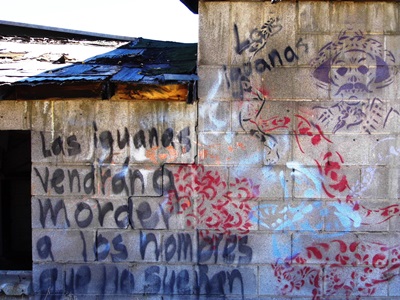
Judging by the stencils, it’s possible the same person wrote this stanza on the back of Araujo’s Grocery itself: Las igyanas (sic) vendrán a morder a los hombres que no sueñan. This is a slight rearranging of a line from Federico Garcia Lorca’s poem, Ciudad sin sueño (Nocturno del Brooklyn Bridge), written in 1929-1930. The translation is: “Iguanas will come to bite the men who do not dream.” Lorca’s work is often pretty surrealistic, but, to me, he is inciting his reader NOT to sleep, but to do, in which case being bitten by iguanas is, in fact, a worthy and motivating experience.
Lorca was executed by a firing squad loyal to Spanish fascist dictator Francisco Franco in 1936, and appears in The Clash tune Spanish Bombs. (“Federico Lorca is dead and gone.”) The Pogues composed an entire song to him, "Lorca’s Novena," in which his corpse walks away. Seeing Lorca’s words as graffiti in a ghost town is quite rare.
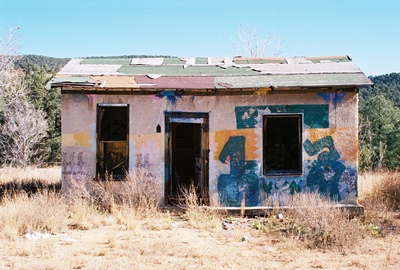
Other visitors to Fierro would seem to include members of Sur 13, the Sureños, a prison gang allied with the Mexican Mafia, MS-13, and the Crips. Their tag is visible in the shot above, as well as elsewhere inside the house.
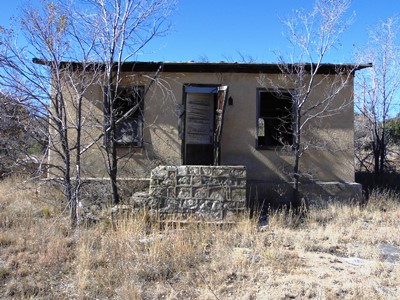
So, while for many ghost towns it is their history that compels, it’s also true that these places have a present and a population of sorts, even if transient. As always, it is only the future which remains uncertain.
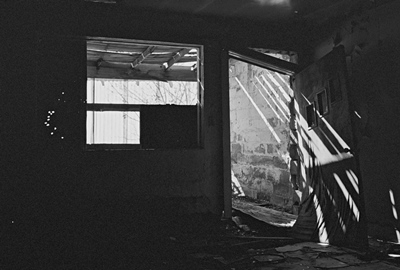
I might as well stop saying that I’m going to post more often because the more I say it the less I actually post. Maybe I’ll just say that I would like to post more often and leave it at that. Could this be seen as a quality over quantity issue instead? Well, whatever the case, after a couple quiet months let’s finally pay a visit to Fierro, New Mexico, in the southwestern part of the state, a few miles due east of Pinos Altos. For a true ghost town, it’s still got a good number of buildings which, while certainly falling, aren’t completely down and out yet, and it has plenty of lonely charm. All you’re likely to hear while exploring is the occasional sound of wood scraping tin when the breeze picks up and maybe the caw of a crow or two flying overhead.
Fierro is an archaic form of hierro, the Spanish word for “iron,” and iron is the reason the town was born in the first place. The mining history goes back to 1841, when Sofio Henkle (or Hinkle), a German immigrant living in Mexico, went looking for copper deposits. He found both copper and iron on a mountain a few miles north of the big copper mine in Santa Rita and named the mountain and its new mine Hanover, after his former home. The town just a couple miles south of Fierro would also be called Hanover (we’ll go there next time).
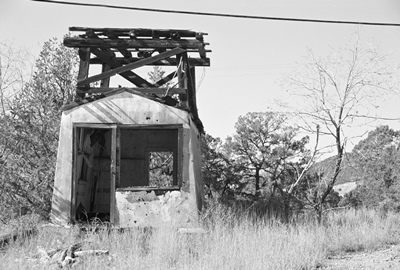
Henkle, however, was soon driven out by Apaches and lucky to escape with his life; he’d been warned of an imminent attack by a friendly Apache woman. Henkle returned years later after New Mexico became a U.S. Territory, believing that he’d be alright now that the army was guarding mines. But then the Civil War required most Federal soldiers to head east and Apaches and Confederates started raiding. So Henkle gave up for good and lived the rest of his life in the Mesilla Valley to the south.
As the 19th century wound down, with the threat of Apache raids gone, and the railroad already having arrived at Silver City—about 15 miles southwest—by the early 1880’s, Colorado Fuel and Iron (CF&I) took an interest in the iron ore deposits of Fierro. A post office was established in 1899, about when the railroad reached Fierro itself, and as much as ten carloads of ore started getting shipped out each day to Pueblo, Colorado, where CF&I were based.
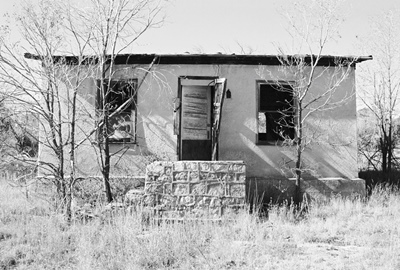
(Above is a home I believe was originally owned by the Bacon family and then the Drakes. Its last owners were the Araujo family, who rented it out.)
The population of Fierro was 750 in 1920 and probably never much over 1,000, even during the peak years between WWI and the start of the Great Depression, by which point six million tons of iron had come from Fierro’s mines. Seventy-eight percent of Fierro’s population was of Mexican descent in 1920, and that percentage increased, reaching the high nineties once the mines closed.
The mines shut down in 1931, although the large Continental Mine ran intermittently and, tragically, in 1947 four miners were killed near it in a “short fuse” accident. While the Cobre Mining Company resumed operations, now with an emphasis on copper, and some residents stayed at least into the 1990’s, Fierro never recovered from the economic blows of the early 1930’s, when people began to leave quickly, many for gold mines in California.
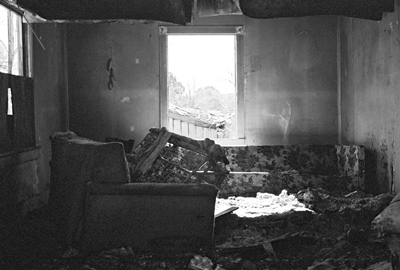
The Gilchrist and Dawson Store, Mrs. Rel’s Rooming House, Filiberto’s Variety Store, McCoy’s Store and post office, John Oglesby’s silent movie house, Sheriff Mac Minter’s pool room; these places were frequented by the miners and their families. Now they’re all gone. Some of them burned in a fire in 1923 when a miner from Mogollon went to sleep at Mrs. Rel’s following a fandango next door and kicked over a kerosene lamp in his room. Without a fire department, and with some buildings even having sidewalks made of wood, much of Fierro’s early commercial district burned fast.
(Below is the Phoenix Mercantile (aka La Tienda del Finicas), which even sold fine furniture. Later it became Araujo’s Grocery and housed the post office. Sitting on the steps waiting for the mail was a common pastime in Fierro.)
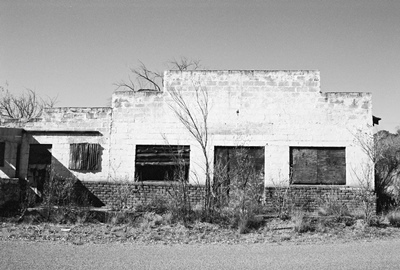
Another building of interest is the little jail by the railroad tracks, near the arroyo that runs through the town (pictured below). In Black Range Tales, James McKenna recalled visiting Fierro in the 1880’s and noted that mining towns punished wrongdoers by tying them to a thick log which had been sunk in the earth with eight feet remaining above ground. Normally prisoners would be released once they’d sobered up and/or calmed down. That could easily take all night. Fierro reportedly did away with its log in the early years, even though the sturdy concrete jail probably never held any true desperadoes.
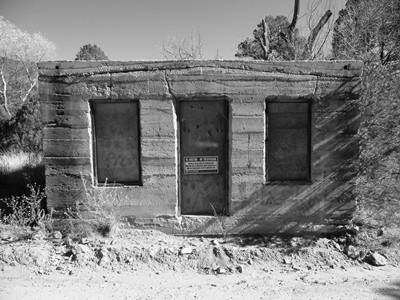
Fierro was known for its love of baseball, with three different fields being used during the town’s history. In the late 1930’s, the team went by the seemingly unusual name “Peru Miners.” Basketball was also popular, with games being played on the school’s dirt court until it was paved in the 1930’s. Fierro even had a Boy Scout troop as late as the 1940’s.
One interesting tradition in Fierro was El dia de las Travesuras, The Day of Pranks, which was a replacement for Halloween. On that night there was no trick-or-treating in Fierro. Instead, kids played pranks, the most common of which was to tip over outhouses. One man spent a night in his outhouse with a shotgun to prevent any hi-jinks, only to have his bathroom toppled anyway when he went back to his house at 2AM for a quick cup of coffee. This never happened to the managers of CF&I as they had indoor plumbing and even electricity. Later, it’s said that a popular prank was swapping around railroad and highway signs, which might cause problems regardless of income bracket.
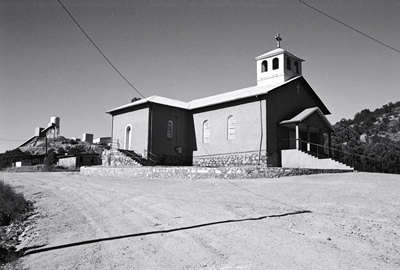
While Fierro is a ghost town now, two places that are very much alive are St. Anthony’s Mission Catholic Church (above), built in 1916 and later enlarged, and, ironically enough, the cemetery, which covers four acres and is lovingly maintained these days. Aside from regular services, a celebration and mass is still held each year on June 13th, the Feast of St. Anthony, and many of those for whom Fierro remains important meet to reminisce and once again walk the quiet streets of the old place.
AUGUST 2017 UPDATE: A Facebook page has been started to document the history of Fierro and the lives of its residents, both through photos and stories. If you're interested in Fierro I highly recommend giving it a look and a "like." The page can be found HERE. As if that wasn't enough, a wonderful photo video showing much of Fierro as it looks today can be found HERE on You Tube. A second video, focused on the shrine behind St. Anthony's Church, is HERE.
Some information for this post came from "New Mexico’s Best Ghost Towns," “Ghost Towns Alive,” and "The Place Names of New Mexico," but the best place to learn about Fierro is “Remembering Fierro (Again) (Revised Edition)" by Frank Ramirez, now available only at the Silver City Museum. It’s not very often that an out-of-the-way ghost town has an entire book dedicated to it, but I’m certainly pleased on the rare occasions when it happens. Mr. Ramirez passed away in 2011 and this post is dedicated to him.
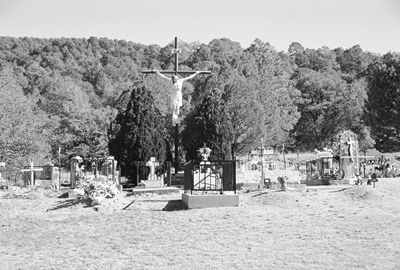
Next time we’ll go back just a couple miles south and check out Hanover, NM. (Well, after this little POSTSCRIPT on the graffiti of Fierro.)


 The Araujo’s rented the home out, but one person that probably didn’t sign a lease was whoever painted the green wall of skulls and maize set against the backdrop of a mountain shown above. The artist clearly spent some time in Fierro and, in fact, the room was swept clean and full of the evidence of a fairly prolonged stay. That evidence included some unusual reading material, such as a book about the influence of computers on society which lay open to a chapter titled, “The Human Difference.”
The Araujo’s rented the home out, but one person that probably didn’t sign a lease was whoever painted the green wall of skulls and maize set against the backdrop of a mountain shown above. The artist clearly spent some time in Fierro and, in fact, the room was swept clean and full of the evidence of a fairly prolonged stay. That evidence included some unusual reading material, such as a book about the influence of computers on society which lay open to a chapter titled, “The Human Difference.”







